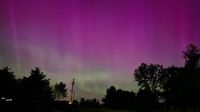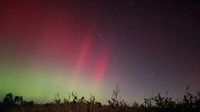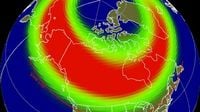DAYTON, Ohio (WKEF) -- A G3 Geomagnetic Storm Watch is currently in effect, with conditions expected to allow the northern lights to dip further south into the northern United States on Wednesday night, April 16, 2025. Just before 5:00 PM, the geomagnetic activity reached a significant level, heightening the chances for a spectacular light display in the night sky.
The aurora borealis, also known as the northern lights, has been known to grace the skies over Ohio in the past, with memorable displays occurring in May and October of 2024. This week, forecasts indicate that a pair of solar eruptions, known as coronal mass ejections (CMEs), are targeting Earth, potentially bringing the aurora to the Buckeye State once again.
According to the Space Weather Prediction Center, if the solar storm hits at a G3 intensity, the aurora could be visible as far south as Lake Erie, possibly making it visible from Northern Ohio. The energized particles from these solar events travel at a staggering speed of 45 million mph, and once they hit the Earth’s atmosphere, they can create the stunning light displays characteristic of auroras.
As the Kp index, which measures geomagnetic activity, is expected to reach levels of 5 to 6 around 8 PM to midnight on April 16, residents in areas like Chicago may also catch a glimpse of the aurora. However, the best views are anticipated to occur in Canada, North Dakota, and Montana, where the colors are expected to be more vibrant.
The aurora typically forms 80 to 500 km above Earth’s surface, with 100 km marking the boundary where outer space begins. This means that the phenomena occur high above our heads, in the realm of outer space. The Kp index chart indicates that G3 level geomagnetic storming could persist until 11 PM, with levels dropping off quickly into the early hours of Thursday morning, April 17.
To optimize viewing opportunities, astronomers recommend finding a dark location away from city lights and avoiding nights with a full moon. The ideal time to observe the northern lights is usually between 10 PM and 2 AM.
Astronomer Dean Regas explained the significance of the upcoming geomagnetic storm watch. He noted that the solar storm is a result of a powerful CME that occurred on April 15, 2025. This particular event was characterized as a "1-2 punch," where a slow burst of solar material was followed by a quicker, more intense eruption, known as a Cannibal CME. Regas emphasized that while CMEs can travel at speeds exceeding 1 million miles per hour, the distance of 93 million miles from the sun means it takes several days for the material to reach Earth.
While the potential for northern lights in Ohio remains, Regas cautioned that predicting auroras is notoriously difficult. "No one knows exactly what kind of event we'll have from the solar blast," he said. However, he expressed optimism about the upcoming solar activity, noting that the sun has entered its solar maximum phase, making it more active for sunspots that generate solar storms.
As excitement builds for the possibility of witnessing the northern lights, the Space Weather Prediction Center continues to monitor solar activity closely. They provide forecasts with a day or two of advance notice, allowing enthusiasts to prepare for potential viewing opportunities.
For those planning to view the aurora, it is essential to be equipped with the right tools. Using a smartphone camera with a long exposure setting can help capture the faint lights. As the weather forecast for the Miami Valley indicates a few clouds before midnight, viewers may still have plenty of opportunities to see the lights if they materialize.
In summary, Ohioans are in for an exciting night as they await the possibility of witnessing the northern lights once again. With the current geomagnetic storm watch in effect and a history of previous sightings in the region, the conditions seem ripe for a memorable celestial display. Whether the auroras will make an appearance remains to be seen, but the anticipation is palpable.



